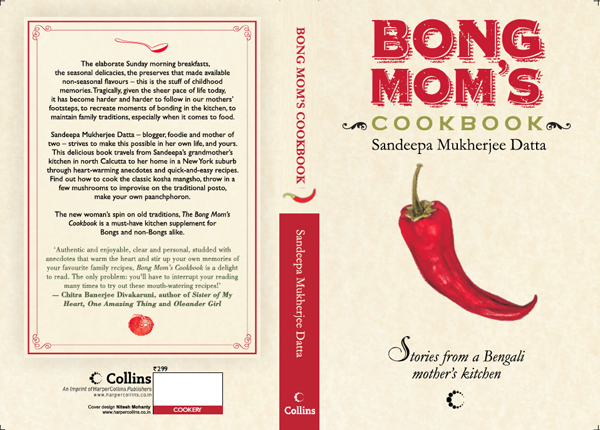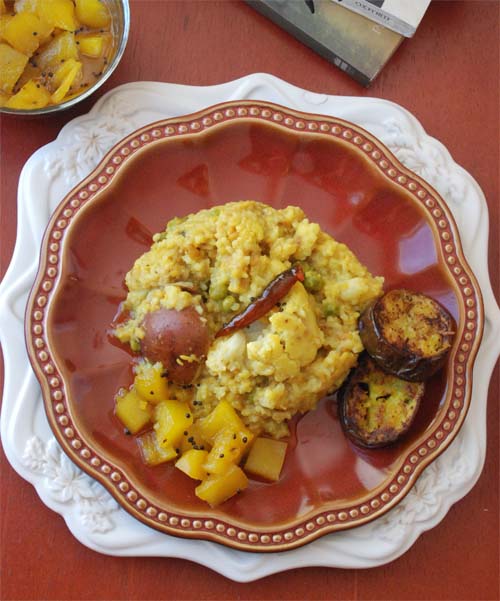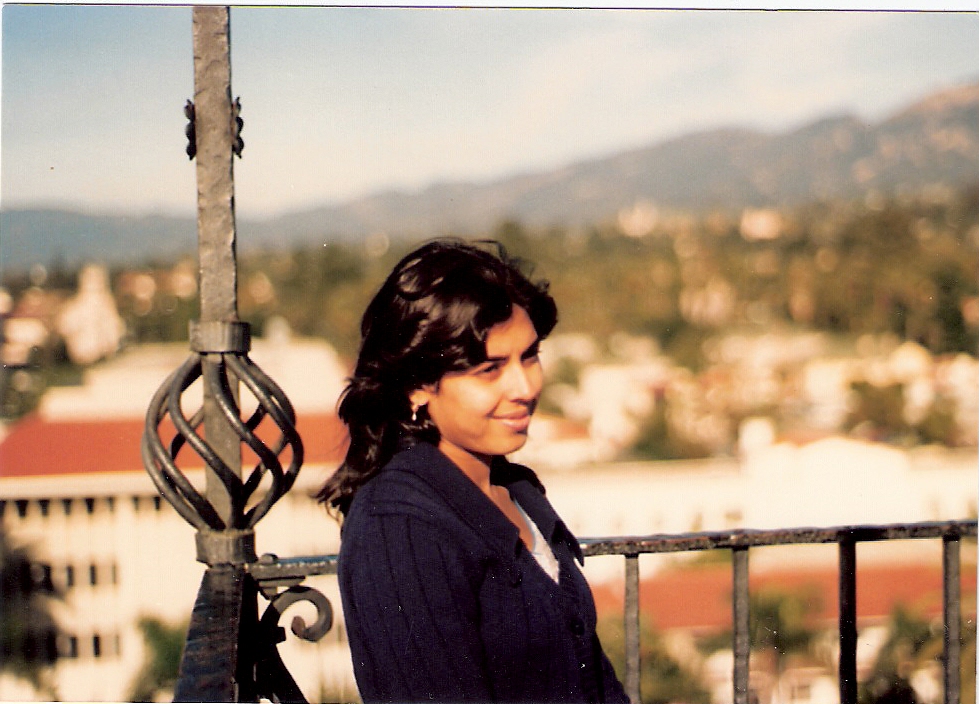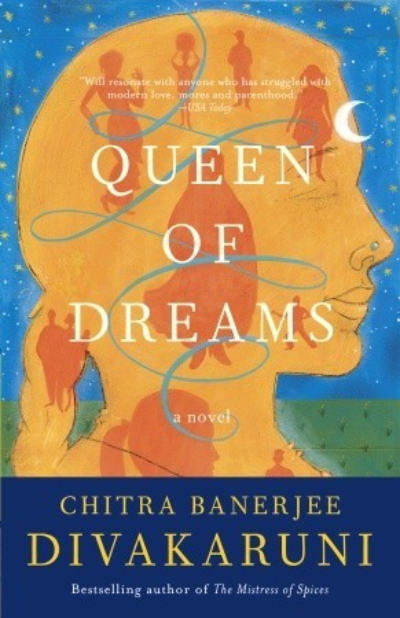One of the things I most enjoy writing about in my novels is food. In all cultures--but particularly in India--food gives us so much more than physical nourishment. It is woven into customs, history, family lore. Through cooking, people demonstrate craft, creativity, love and pride.
In Oleander Girl, my newest novel, set partly in Kolkata and partly in the U.S., food plays an important role and gives us a glimpse into the hidden depths of the characters. In the traditional household of the heroine Korobi, we find authentic Bengali cuisine--fried brinjal and khichuri, but prepared by a long-time cook given to wild improvisations. In Korobi's fiance Rajat's elegant, westernized home, Rajat's father makes tiramisu. In New York. Desai, the private investigator who helps Korobi in her search for a family secret, fixes pau bhaji in memory of his dead sister.
Today I've invited Sandeepa Datta, a wonderful cook and the author of Bong Mom's Cookbook, to share a couple of recipes that appear in Oleander Girl. I have a feeling that you're going to love her easy, healthful versions.
Over to Sandeepa now. Please scroll down to the bottom for more information about her delicious book.
SANDEEPA WRITES:
I am very proud today to share a few of my recipes with Chitra Banerjee Divakaruni. She has been an author whose writing I have loved since her first book "Arranged Marriage". When I migrated to US in 1999, her books echoed my thoughts and I felt a certain familiarity in her stories. They spoke to me. Her fictional characters were like my friends in this new country. There have been times when I have found strength from Anju in “Sister of My Heart”. When Chitra Banerjee very kindly wrote the cover quote for my book, I was elated.
And today I am very happy to share recipes of some of the Bengali food mentioned in “Oleander Girl” with you all.
Begun Bhaja
“Luncheon smells rise from the kitchen – khichuri made with golden mung and gopal bhog rice from their ancestral village, sautéed brinjals, cabbage curry cooked with pure ghee and cardamoms. Sarojini will have to supervise the fish fry.” –Oleander girl
Begun Bhaja or Sautéed Eggplant is a very simple Bengali delicacy. Simply put it is slices of purple eggplant, tossed in turmeric powder and salt and then shallow fried in hot oil. With a good quality eggplant, the flesh of the fried begun is so soft that it is not wrong to call it "buttery". Growing up, begun bhaja was a standard side with dal and rice and a fish curry in most Bengali homes. It was also served with fried flatbreads called Luchi or with a rice and lentil mix called Khichuri.
Though Begun Bhaja is originally shallow fried in sharp pungent Mustard oil, I try to make a healthier version where I toss them in olive oil and bake them in the oven. Here I am sharing a version where I bake them in the oven. You can choose to shallow fry in oil instead. Easy and delicious.
Wash 1 slender japanese eggplant in water and pat dry. Dry it well.
Chop the eggplant in rounds, each 1/2" thick.
Toss the slices with
1 tsp turmeric powder
2 tsp Olive oil
salt to taste
To make it more global you can use some other spices like paprika or cumin powder too.
Grease a baking tray. Arrange the eggplant slices on the tray. No piling or overlapping. If you have a cooking spray, spray the surface of the eggplant slices. Or else you can smear them with drops of olive oil. Make sure that each slice is coated with a layer of oil else it will get dry.
Pop in an oven. I used a toaster oven where I baked them at 300F for about 25-30 mins. After 15 mins from start I turned the tray and sprayed the slices once more. Towards the end, I flipped the slices, sprayed with little more cooking spray and did it for 5 more minutes.
Oven temperature and timing will vary. At my home, the larger oven temp needs a higher temperature, around 350F for same recipe. Also depending on the quality of the eggplant timing will vary. Just check that the slices are not getting dry and take them out once they are soft and cooked. If they are getting dry but not cooked, cover the bake tray with a aluminum foil and then bake.
Sometimes I might brown them further on a greased fry pan on the stove after they are done but mostly that is not necessary for this variety of eggplant.
Khichuri or a Khichdi made with Golden Moong dal and rice is a Rice and Lentil dish akin to Risotto if I try going international. The same Khichuri when mixed with devotion, faith, respect and fragrance of incense, is lifted to the sublime and offered to Gods, it is called Bhog er Khichuri.
This recipe of Khichuri is very flexible and you can work around it with ingredients you have in hand. You can also add more vegetables to suit your taste and skip some. The whole spices that have been used to temper the oil are a staple in any Indian kitchen but if you lack a couple of them, don’t get flustered. Go ahead and try the dish even if you have only a couple of the spices. Those spices are used to flavor the oil in Indian cooking and not meant to be eaten whole.
Same for Ghee. Ghee lends an awesome flavor to this dish but you can substitute with Butter if your pantry lacks Ghee. I would say don’t hold back but adapt the recipe to make it your own in your own kitchen.
Just like in Sarojini’s Kitchen (in Oleander Girl) serve this Khichuri with Begun Bhaja or sautéed eggplants.
A liitle prep
Chop 2 medium potatoes in halves.
Chop half of a small cauliflower in about 8-10 large-ish florets
Defrost about 1/3 cup of frozen peas (or use same amount of fresh green
peas)
Wash 1/2 cup of rice and soak in water. Short grained gobindobhog rice is best but basmati will also do.
Roast 1/2 cup of Yellow Moong Dal till you get a nice nutty aroma. About 50% of the dals should be a light brown on roasting. Rinse the dal lightly in water and keep aside.
In a separate frying pan, fry the potatoes and cauliflower with sprinkle of turmeric powder till they are a shade of light gold and the cauliflower florets have some brown spots.bThrow in the green peas and sauté them too.
After we are done with the prep part we will start on the actual khichuri
Heat 1tbsp vegetable oil + 1 tsp ghee in a deep and heavy bottomed pot.
Temper the oil with
2 green cardamom
2-4 clove/laung
1 thin stick of cinnamom
1 Bay Leaf/tejpata
2 Dry red chilli
1/4 tsp of whole cumin seeds/jeera
When the spices pop add
1 tbsp mince or grated ginger
1/2 tsp cumin powder
1/2 tsp Red chilli powder(or Kashmiri Mirch)
Saute for a minute. Adjust the chilli powder to you taste.
Next add the roasted moong dal and mix with the masala. Saute the dal along with the masalas for couple of minutes.
Now add about 2 cups of warm water to the pot. Add little salt. Cover the pot and let the water simmer to a boil. 2-3 minutes after the boiling starts add the potatoes, cauliflower and peas. Add some more warm water if needed. Cover the pot and let the vegetables cook for 2 more minutes. The moong dal takes longer to cook than the rice so we want the dal to be cooked half-way before we add the rice.
Add about 1/2 cup of short grained rice now. Mix with the lentils and veggies and add about 2 more cups of warm water, salt to taste, ½ tsp turmeric powder. Once you see the water boil, lower the heat, cover the pot and let the rice and lentils cook. In between, remove the cover, gently give a stir and check if they are done or if more water is needed.
Once the rice, lentils and vegetables are cooked, sprinkle about 1/2 tsp of sugar and a pinch of Garam Masala. Mix gently. Drizzle a tsp more of ghee if you are feeling generous. Serve hot.
Some of the other recipes from Oleander Girl can also be found in my blog:
Fish Fry -- Bengali Fish Fry, a Bengali version of their British legacy, breaded and fried fish-- http://www.bongcookbook.com/2009/11/bengali-fish-fry-anglo-bangla-fry.html
Cabbage Curry -- BandhaKopir Ghonto -- http://www.bongcookbook.com/2009/03/bandhakopir-ghonto-dry-cabbage-dish.html
Sondesh -- A popular Bengali dessert made of chhena or homemade cottage cheese -- http://www.bongcookbook.com/2012/10/sondesh-fabled-bengali-sandesh.html
Recipes for Cholar Dal and Paayesh are in my book.
ABOUT SANDEEPA AND HER BOOK:
Sandeepa writes: I am a food blogger, blogging about Indian food, mainly Bengali food from the eastern part of India at "Bong Mom's Cookbook". The blog is about the food I cook at home, for my family, gathering recipes from my Mother, Grandmother, Aunts et al in far off India.
Recently my book based on the blog was published by Harper Collins.
The book has been much acclaimed by Indian media and here is what a leading Indian daily "The Indian Express", says about it, "a rich tapestry of recipes weaved in between stories of Datta's childhood in West Bengal and Bihar and post-marriage life in New Jersey. ....a hilarious read where Didas' and Mashis' grumble about the inequity of neighbours and the planning of weddings all the while trying to raise offspring on a diet of Maach and Rabindrasangeet."
The book is not written as a traditional cookbook and is an enticing mix of food related anecdotes and traditional Bengali recipes. This is what I write in the "Introduction" on the book and which I feel rightly surmises the book.
"As I see it, recipes are a mere framework, guidelines to help you create your own food memories; to experiment and make it your own; to find your own joy and spice box in the kitchen and to weave your own tale. That is what I want you to do with the recipes in this book. I did not write this book as a cookbook and the recipes shared here are those I cook at home according to the tastes of my family of four. When it comes to you, adjust, taste, create and, most importantly, enjoy the process, for the food is good but the story that you knit around it is better. This is my story, but it might well be yours and maybe even yours. "
The book is available from Amazon and Flipkart. More about the book here: http://www.bongcookbook.com/p/the-book.html














